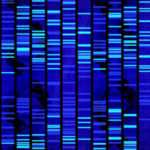
Bioinformatics and biostatistics
for genomic and transcriptomic data analysis
Gene expression analysis
Thanks to its bioinformatic department, DIAG4ZOO has a unique expertise in gene expression analysis and in the identification of specific RNA biomarkers. The bioinformatic and biostatistic methods and tools used have been tested and validated in recent scientific publications and guarantee the reliability and efficiency of our processes.
Bioinformatics and biostatistics for sequencing data analysis

Diag4zoo developed statistical methods and bioinformatics tools dedicated to the analysis and management of massive amounts of genomic and transcriptomic data generated by sequencing. The technical team adapts its tools, software and algorithms to the specifications of each specific analysis and processing.
The Diag4zoo team uses customized pipelines and algorithms for :
- Transcriptome studies, including gene expression (coding or non-coding) or splice variants
- Genome studies, including genome and metagenome analysis, exome, methylome or degradosome analysis
Thus, for each of the analyses and each of the steps constituting these analyses, Diag4zoo chooses and adapts the tools and parameters to answer the most precisely the biological question studied.
Bioinformatics and biostatistics for sequencing data analysis

Diag4zoo developed statistical methods and bioinformatics tools dedicated to the analysis and management of massive amounts of genomic and transcriptomic data generated by sequencing. The technical team adapts its tools, software and algorithms to the specifications of each specific analysis and processing.
The Diag4zoo team uses customized pipelines and algorithms for :
- Transcriptome studies, including gene expression (coding or non-coding) or splice variants
- Genome studies, including genome and metagenome analysis, exome, methylome or degradosome analysis
Thus, for each of the analyses and each of the steps constituting these analyses, Diag4zoo chooses and adapts the tools and parameters to answer the most precisely the biological question studied.
Transcriptome Analysis
In RNA analysis, several types of RNA and processes can be analyzed separately or together. Indeed, the RNA family is a very important family including mRNAs (messenger RNAs coding for proteins), and non-coding RNAs such as miRNA (microRNA) or lncRNA (long non-coding RNA). The analysis tools and/or parameters used in the analyses are specific to each type of RNA.
Similarly, in the analysis of a process such as splicing, the bioinformatic approach requires a deeper analysis, i.e. we must no longer consider an RNA as a single entity, but analyze, identify and count all the exons that compose it. The proposed approach to study these transcriptomes is RNA-Seq: high-throughput sequencing (NGS) of all messenger RNAs present in a given condition.
The transcriptome analysis pipeline consists in the following main steps :
- Quality control and sequence cleaning
- Mapping on the reference genome
- Counting of mapped sequences
- Normalization and comparison
- Sequence annotation
- Study of expressed genes: differential analysis, visualization and statistical validation

Transcriptome Analysis

In RNA analysis, several types of RNA and processes can be analyzed separately or together. Indeed, the RNA family is a very important family including mRNAs (messenger RNAs coding for proteins), and non-coding RNAs such as miRNA (microRNA) or lncRNA (long non-coding RNA). The analysis tools and/or parameters used in the analyses are specific to each type of RNA.
Similarly, in the analysis of a process such as splicing, the bioinformatic approach requires a deeper analysis, i.e. we must no longer consider an RNA as a single entity, but analyze, identify and count all the exons that compose it. The proposed approach to study these transcriptomes is RNA-Seq: high-throughput sequencing (NGS) of all messenger RNAs present in a given condition.
The transcriptome analysis pipeline consists in the following main steps :
- Quality control and sequence cleaning
- Mapping on the reference genome
- Counting of mapped sequences
- Normalization and comparison
- Sequence annotation
- Study of expressed genes: differential analysis, visualization and statistical validation
Genome analysis

In the same way as for transcriptome analysis, genome analysis can be approached in different ways: the analysis of coding regions for RNAs (Exome), the search for methylation sites on DNA (Methylome) or the search for sequence variants representative of somatic (non-hereditary) or constitutional (hereditary) mutations on DNA, characterized by insertions/deletions (InDels) or by single nucleotide mutations (SNVs) on DNA
Studying the exome of an individual consists in studying the genetic variations of the coding part of the genome under a defined condition.
Exome analysis consists in the following main steps :
- Quality control and sequence cleaning
- Mapping on the reference genome
- Accurate detection of InDels (Insertions/Deletions)
- Precise detection of SNVs (Single Nucleotide Variants)
- Sequence annotation
- Differential analysis, visualization and statistical validation
Genome analysis

In the same way as for transcriptome analysis, genome analysis can be approached in different ways: the analysis of coding regions for RNAs (Exome), the search for methylation sites on DNA (Methylome) or the search for sequence variants representative of somatic (non-hereditary) or constitutional (hereditary) mutations on DNA, characterized by insertions/deletions (InDels) or by single nucleotide mutations (SNVs) on DNA
Studying the exome of an individual consists in studying the genetic variations of the coding part of the genome under a defined condition.
Exome analysis consists in the following main steps :
- Quality control and sequence cleaning
- Mapping on the reference genome
- Accurate detection of InDels (Insertions/Deletions)
- Precise detection of SNVs (Single Nucleotide Variants)
- Sequence annotation
- Differential analysis, visualization and statistical validation
Metagenome analysis and microbiome studies
Metagenomics is the study of all the genomes present in a complex environment and in a given condition. Studying the microbiota of an individual consists in identifying the genomes of the bacteria or viruses present in a salivary or intestinal sample or on the skin. This analysis can consider complete genomes or target specific regions, such as the analysis of 16S RNA (ex V3-V5) in studies of human intestinal microbiota.
The microbiome analysis consists in the following main steps :
- Sequence quality control
- Cleaning and grouping of representative sequences into OTUs (Operational Taxonomic Units)
- Counting of populations
- Taxonomic analysis of samples (species detection)
- Population and diversity analysis (Alpha, Beta diversity)
- Differential analysis, visualization and statistical validation

DNA analysis from complex samples
Next-generation sequencing (NGS) combined with cutting-edge bioinformatics tools can reveal the presence of certain DNAs, even in very small quantities, in a complex sample.
This type of analysis requires a precise, methodical and rigorous process, from sample preparation to bioinformatics analysis, which enable to decode the nucleic sequences obtained. The raw sequencing data are then subjected to a sophisticated bioinformatics analysis, which involves aligning the sequences with reference genomes, identifying variants and creating a detailed profile of the genomes studied or researched.
For example, the algorithms used aim not only to identify known viruses and their potential genetic variants, but also to detect unknown viruses or combinations of viruses, with exceptional sensitivity.

Metagenome analysis and microbiome studies

Metagenomics is the study of all the genomes present in a complex environment and in a given condition. Studying the microbiota of an individual consists in identifying the genomes of the bacteria or viruses present in a salivary or intestinal sample or on the skin. This analysis can consider complete genomes or target specific regions, such as the analysis of 16S RNA (ex V3-V5) in studies of human intestinal microbiota.
The microbiome analysis consists in the following main steps :
- Sequence quality control
- Cleaning and grouping of representative sequences into OTUs (Operational Taxonomic Units)
- Counting of populations
- Taxonomic analysis of samples (species detection)
- Population and diversity analysis (Alpha, Beta diversity)
- Differential analysis, visualization and statistical validation




